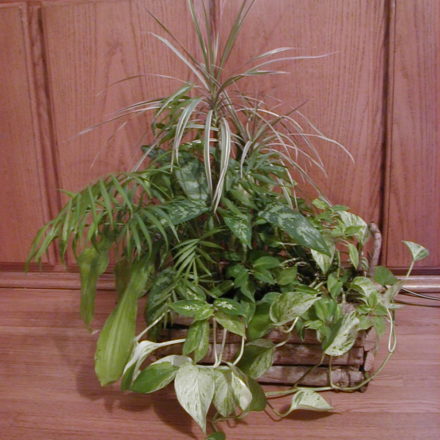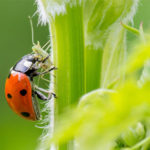Besides being eye-catching, mixed plantings are also low maintenance. Plants that would otherwise grow large on their own markedly slow down their growth in a group-growing situation, staying compact.
Mixed plantings are often created in baskets, but they can also be planted in pots or planter boxes, depending on the look you’re trying to achieve. You can pot all of the plants in the same container–which is a more long-lasting solution–or you can fit individual pots into a bigger pot or basket and cover with moss. The latter approach will mean tending to each individual pot and replacing the plants as they outgrow their containers. If you choose your plants carefully, it’s possible to plant all in the same pot and have those plants thrive together

For the best of luck, choose plants that require the same conditions, which isn’t that hard when it comes to houseplants. Most common indoor plants do well together, except for those that require very specific conditions, such as succulents and cactus, orchids, various herbs and African violets. If a houseplant in the group isn’t behaving, it’s easy to remove it and replace, or simply let the remaining houseplants fill in the gap. To create visual interest, choose plants of varying heights.Good choices for a small basket would include tall plants such as small dracaenas, ficus, peace lily and palms; medium plants like
aluminum plant, cast-iron plant, coleus, mosaic plant, and trailers like ivy, pothos, spider plant and philodendron. You will need only one to two tall plants for your planting, depending on the size of the container.You can plant in a basket or pot. Baskets should be lined with heavy plastic, which will prevent the basket from getting overly moist and will keep in the soil. Punch a few holes at the bottom of the plastic for drainage. Containers should also have sufficient drainage holes.Mixed plantings can be planted close to give a full, lush look. In general, you will want a 4- to 5-inch square area for each plant. Use this ratio to decide how many plants you need for the container you’ve chosen. Plant your tallest plant in the center of the container. Next, surround the tall plant in descending order of height with medium to low growing plants. Trailing and hanging plants should be planted on the edges of the container so they gracefully drape and trail over the sides.Care for mixed plantings like all other houseplants. If you’ve chosen plants with differing needs and have them in separate containers, treat individually with the proper amount of water and fertilizer. If the planting is combined, water when it approaches dryness and feed with an all-purpose organic food on a monthly basis from April through October. Keep an eye out for pests. Because mixed plantings consist of a variety of plants growing closely together, unwanted visitors can sometimes creep in without notice.





